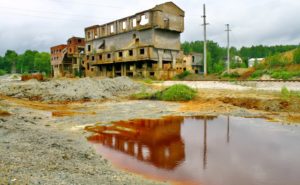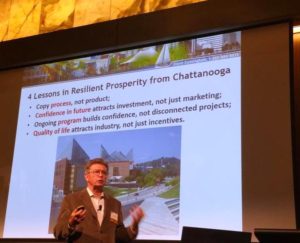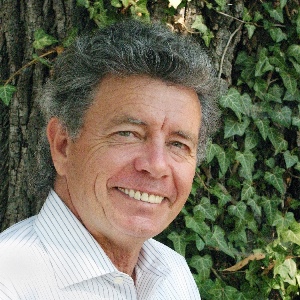This article is an editorial by Storm Cunningham, publisher of REVITALIZATION.
There are five articles (plus a video) about Detroit, Michigan in this issue of REVITALIZATION. This wasn’t by design: there simply happens to be a huge amount of revitalization activity going on in Detroit these days.
Of course, that’s not news to long-term readers of REVITALIZATION, or of the news media in general. I mention it because Detroit exemplifies many of the points made in the following article.
While the public and private leaders of this great city certainly take advantage of every opportunity to tap state and federal funding to advance their redevelopment, they are by no means dependent on it.
I have no doubt that their renewal process would continue, albeit at a slower pace, were such funding to disappear entirely during the current administration in Washington, DC.
As one of the articles in this issue points out, all is not rosy in Detroit, especially in those neighborhoods not yet touched by all this regenerative activity. Nor would anyone expect it to be, given the darkness of the depths to which the city sank in recent decades.
What’s special about the Detroit renaissance is the sheer depth and breadth of activities. Sure, the city is blessed with several well-known “knights in shining armor”, and their efforts are of huge value. Sure, they’ve got one of the best mayors in the nation (after a long strong of disastrously-bad ones).
But there are literally thousands of non-profits, foundations, neighborhood groups, private redevelopers, and green/social/restorative entrepreneurs at work renewing at smaller scales throughout the city. This “war” on blight and depression isn’t one that could be won by sniping a general. This is a citizen-powered guerrilla war that also happens to enjoy the benefits of having some generals commending conventional forces.
The result is a continuous stream of good news. While all these on-the-ground civic improvements are important to the local economy and quality of life, the most valuable effect of this constant good news is perceived momentum, which spawns confidence in the local future.
Nothing is more crucial to revitalization success than inspiring such confidence, both in the local citizens, and in the nation and world at large. Here’s why:
THE PROBLEM. Over-dependence on ephemeral federal funding.
This article shows how to build local renewal capacity, making your city or region less vulnerable to the ebb and flow of state and federal funding that often accompanies changing political administrations. These lessons apply to cash-strapped communities anywhere in the world. But it was written primarily due to the Trump administration’s “freeze” on Environmental Protection Agency grants and contracts, which has thrown hundreds of local redevelopment programs into a state of emergency.
Of course, the U.S. federal government has many other programs that help places with their various regenerative agendas: revitalizing downtowns, restoring natural resources, renovating historic buildings, renewing infrastructure, remediating contaminated properties, etc. Such programs are, in general, highly-efficient uses of federal funds, with a very high ROI (more on this later).
But over-reliance on such funding can trigger local crises when such funds dry up, whether due to a national economic downturn, or to regime change. At such times, communities might find that they’ve become overly-dependent on federal funding (or on state funding derived from federal programs). At this point, they need to make a choice: cut back on revitalization efforts, or find a way to dramatically offset the loss via private investment.
Now, the search for private investment in community renewal is nothing new: it’s a perennial challenge that has simply been worsened by the current administration’s antipathy towards federal spending of all kinds. Even if the freeze were lifted tomorrow, the challenge of increasing private dollars will persist. The good news is that the solution remains the same in either case: boosting confidence in your local future. The bad news is that few local leaders truly understand how to do it.
SOLUTION #1. Increasing confidence in the local future should be your goal: It’s the primary factor for employers and residents when deciding whether to move to your community, or to stay in it.
 Community revitalization is a confidence game, in the best sense of the phrase. Too many programs focus on the type of asset: waterfront, brownfield, historic, infrastructure, public space, etc. In other words, they focus on nouns (stuff). But private investors are primarily interested in one verb/gerund: Revitalize/revitalizing.
Community revitalization is a confidence game, in the best sense of the phrase. Too many programs focus on the type of asset: waterfront, brownfield, historic, infrastructure, public space, etc. In other words, they focus on nouns (stuff). But private investors are primarily interested in one verb/gerund: Revitalize/revitalizing.
Resilient prosperity can be considered the universal desired outcome of a revitalization or resilience effort. The universal strategic goal of revitalization efforts should be increasing confidence in the local future. All revitalization efforts that fail to bring a distressed place back to life tend to have one thing in common: they don’t convince enough people that the local economy and/or quality of life will improve. The reasons such initiatives fail to boost confidence vary widely—lack of vision, poor strategy, dysfunctional design, bad implementation, etc.—but that one strategic failure is fairly universal.
Real estate investors primarily look for evidence that properties will be more valuable in the future than they are now. This confidence in increased future value is often based more on what’s happening on surrounding properties—and in the community as a whole—than it is on the property in question. The buy-low/sell-high dynamic is of far more importance than what it is that’s being bought and sold.
Investors care little about the condition of an asset when they buy it. What they care about is whether it will be worth more in the future. They’d rather invest in a rusted-out hulk of a 1957 Chevy, knowing it will appreciate dramatically after restoration, than a brand-new Chevy whose value will only go down.
And they’d rather buy property in a depressed, run-down town that they’re confident is on its way up, than in a beautiful city that’s on its way down.
Avinash Persaud, chairman, Intelligence Capital Limited (London, UK) once said “Money, in the end, is confidence.” Without confidence in the future value of a $20 bill or a €20 note, they are just worthless pieces of paper. And so it is with local economies.
The right revitalization strategy—along with an ongoing program to implement it—should build confidence in your local future. That’s the key to attracting/retaining residents, employers, and investors. If there’s a universal revitalization goal, that’s it. “Local”, in this case, can mean very local. In several U.S. cities, for instance, merely announcing a future trolley line was enough to revitalize the area along its intended path, before a single track was laid. Why? Confidence in the revitalized future of that corridor.
The long-depressed Canal District of Worcester, Massachusetts is now revitalizing, based on confidence that their historic canal—buried for over a century—will someday be daylighted, thereby providing a revitalizing water feature. But they have neither the money to unearth it, nor an official plan for doing so. What provided that confidence? A clear, credible vision of how the area would be changed for the better, plus a trusted organization (the Canal District Alliance) to devise and follow-through on a strategy.
Reduced confidence in the global future is fast becoming one of the largest economic impacts of climate change. The vast majority of the planet’s population and economic activity is close to coasts. Rising sea levels, combined with the increasing frequency and severity of storms, is rapidly eroding confidence in the future of coastal cities worldwide.
Add in the rise of global terrorism, and it’s not surprising that Andrew Young, former U.S. Ambassador and former 2-term Mayor of Atlanta, Georgia says “The environment is so insecure and unstable right now that people are afraid to invest in the future.”
So now, on top of all the usual challenges to revitalizing their communities—financing, pessimism, political infighting, corruption, street crime, traffic, racial strife, pollution, decrepit infrastructure, etc.—local leaders must contend with reduced confidence arising from terrorism (from domestic and foreign fundamentalists), climate change-induced disasters, and politically-induced funding disasters.
SOLUTION #2. Create a strategy and comprehensive process to boost confidence in the local future.
 As a regenerative economist, I’ve been helping cities and regions worldwide revitalize for over 15 years. The two most common reasons I’ve encountered for failure to inspire confidence in the local future are 1) lack of strategy, and 2) lack of a comprehensive renewal process. Visionaries, designers, planners, policymakers, and project managers abound. Strategists are rare.
As a regenerative economist, I’ve been helping cities and regions worldwide revitalize for over 15 years. The two most common reasons I’ve encountered for failure to inspire confidence in the local future are 1) lack of strategy, and 2) lack of a comprehensive renewal process. Visionaries, designers, planners, policymakers, and project managers abound. Strategists are rare.
Many folks confuse strategies with actions. Actions are tactics: strategies determine tactics. Others confuse strategies with goals. They might say “our strategy is to make this a greener or more equitable community“. That’s a goal.
Strategy is the technique that simplifies and speeds the process of reaching the goal. Many factors contribute to success, of course, such as efficiency, quality of work, etc. But strategy is the only element of an endeavor whose sole function is to make it succeed. If it’s a bad strategy—or if the competition has a better strategy—failure is still possible. But without a strategy, failure is likely.
Everyone uses the word “strategy”, but few understand it. Everyone says they have a strategy, but few can state it. Everyone knows what a tactic is, and assume a strategy is a collection of tactics. Nope: that’s a plan. Some dictionaries even define strategy as a “plan” for achieving a goal. Little wonder, then, that folks are confused as to the difference between a strategy and a plan. One difference is that people with a strategy tend to take action. But with planning, the norm in most cities is “plan and forget”.
Even among those who know they need a strategy, few know how to create a good one. And even fewer know how to implement one, so the strategy often gets lost when the plan is being written. That’s akin to an author who forgets the plot while writing a novel. But, unlike a bad novel, a bad plan can ruin millions of lives for decades. Planning without a strategy is planning for failure.
Here’s a quick test you can try: the next time you’re talking to a mayor, planner, or developer who says they are going to revitalize a place, ask what their strategy is. If they’re still talking a minute later, they might have a strategy, but not a good one. If they say “Read the plan“, they don’t have one, but might not know it. If they say “Go to hell“, they don’t have a strategy, and they know it.
Too many places fall into a superficial, “consumer–style” approach to revitalization. They buy some streetscaping, or some downtown banners, or a branding campaign, or a new employer (purchased with tax breaks).
All of these tactics can contribute to revitalization, but they shouldn’t confused with an actual strategy or process. Many places start the revitalization process, such as with a public visioning session, but lack other key elements. With missing steps, their efforts tend to be unproductive, or less-productive. The two most common gaps in the regeneration process are strategy and ongoing program. So, let’s start by clarifying their roles in the overall process:
- Visions guide actions to the desired outcomes;
- Strategies drive actions to success;
- Partners fund or support actions;
- Policies enable strategic actions;
- Plans organize actions;
- Projects are actions;
- Programs perpetuate, evaluate, and adjust actions. Ongoing programs create synergies, capture momentum (to grease the wheels for more projects), and inspire confidence in the local future.
Of those seven action elements, the plan—which often takes longest to produce and approve—will likely be obsolete the soonest. Complex systems (e.g. cities, ecosystems) resist rigid, imposed order.
Ironically, many places only have a plan. The common result is a plan without funding to implement it. Unfunded plans are so common that many folks consider them normal. In reality, they are often just for show, and shouldn’t be allowed. The strategy (supported by partners and policies) should yield funding, since its job is to create success. Strategize first. Then plan.
 Ongoing programs are especially important due to a universal behavior psychologists refer to as “recency bias“. Humans tend to extrapolate the past into the future, but we put extra emphasis on recent events. Investors flock to a stock (or a market) that’s been rising steadily, even though looking further into the past reveals the likelihood of a downturn.
Ongoing programs are especially important due to a universal behavior psychologists refer to as “recency bias“. Humans tend to extrapolate the past into the future, but we put extra emphasis on recent events. Investors flock to a stock (or a market) that’s been rising steadily, even though looking further into the past reveals the likelihood of a downturn.
Applied to community economic growth, this means that the $1 million redevelopment of a historic building into a new hotel that opened last week will inspire more confidence in the future of a community than the $200 million convention center that opened 3 years ago. An ongoing program that spawns a constant flow of small and medium-sized renewal projects will likely attract more investment to your city than will large projects that occur once every 5 or 10 years.
The key is to have a comprehensive process for growing confidence in your local future. One-time projects—no matter how spectacular—will seldom produce lasting confidence. Neither will just having a vision. Or just having a strategy. Or just having a partnership. The following graphic shows all the elements of a comprehensive process for growing your economy, your quality of life, and confidence that both are on the upswing.
All of nature is based on constant regeneration. All productive (and destructive) outcomes are based on processes. Our bodies, ecosystems, and economies thrive on a constant process of repurposing, replacing, renewing, and reconnecting existing components.
Most cities ignore process, taking a haphazard approach to revitalization that relies on “magical outcomes.” They just do a bunch of stuff and hope for the best. They often try to substitute quality of process with quantity of effort, assuming that a few big projects are more likely to revive a place than lots of little ones.
Public and private leaders tend to treat regeneration as if it has no essential underlying principles, frameworks, or components. They take whatever approach seems to be dictated by their available human, organizational, physical, and capital resources. Instead, we must adapt local government to the core revitalization process, not try to adapt the revitalization process to local limitations. Innovative partnering is often the tactical key to funding effective renewal strategies, as this Pennsylvania county proves.
Money can fix some problems, which leads those looking for simplistic solutions to assume it can fix most problems. The reality is far more complex, and can only be addressed with an adaptive, strategic, process-oriented approach.
CONCLUSION. Boosting local renewal capacity–and confidence in the future–should be your priority, whether federal funding is increased, frozen, or decreased.
As mentioned in the opening, many U.S. communities are currently in a panic over the Trump administration’s “freeze” on EPA funding and contracts, which are at the heart of literally thousands of brownfields and other local redevelopment efforts.
Of course, the USEPA isn’t the only federal agency providing support for urban and rural redevelopment, restoration, and revitalization initiatives. Other major providers include HUD, USDA, EDA, NOAA, NPS, and USDOT.
EPA was singled out primarily because anything with “environmental” in the name is considered progressive, and thus an enemy of the conservative agenda. This is ironic, since the EPA was created by a Republican president, the Clean Water Act was passed during a Republican administration, and Republicans supported the various iterations of the Clean Air Act. It shows how thoroughly polluting industries have co-opted the conservative agenda over the past half-century.
But the freezing of EPA funding is also ironic because the EPA’s brownfields program is well-documented to be most efficient of all federal spending. Every dollar of public funds put into helping communities identify, evaluate, and remediate contaminated properties produces returns of investment (ROI) ranging from a low of 4:1 to a high of 44:1 (Minnesota), depending on the efficiency of local brownfields programs. Everyone, progressive and conservative alike, wants to reduce government waste. But attacking the programs that offer the highest ROI seems an illogical and counter-productive place to start.
The good news is that an EPA insider tells me it’s not really a freeze; just a “pause” to allow the incoming administration’s team to understand what it is EPA does in these arenas. He says all contracts/grant actions have been allowed to go forward. That good news aside, these are dangerous times for communities anywhere in the world to be overly-dependent on federal or state funding.
Rather than reacting to the next funding crisis, the best path is to focus immediately on inspiring solid confidence in the future of your place. Here are three concrete first steps:
- Start enhancing your renewal capacity now. Create a comprehensive process, comprising vision, strategy, policies, partners, plan, projects, and program;
- Build momentum now with a real project at whatever scale you can afford. To get the most from your investment, be sure it repurposes, renews, and/or reconnects existing assets;
- Get private investments flowing now. Do it before you become so desperate for it that you lose precious bargaining power when you meet around the public-private partnership table.
Whatever specific financial, legal, and technical skills you personally bring to that table, your mastery of this “confidence game” is critical to advancing your area’s Restoration Economy.
To learn more about strategizing, and the comprehensive process for resilience and/or economic growth, read this new Regenerative Strategy Guide, from which a few parts of this article were excerpted.
About the Author:
 Storm Cunningham is the publisher of REVITALIZATION. Since 2002, he’s been a full-time futurist, public speaker, and resilience economist.
Storm Cunningham is the publisher of REVITALIZATION. Since 2002, he’s been a full-time futurist, public speaker, and resilience economist.
He is the author of The Restoration Economy (Berrett Koehler, 2002), and reWealth (McGraw-Hill, 2008). His next book is RECONOMICS (coming January 2020).
Learn more about his books, talks, workshops, and consulting at StormCunningham.com [Image: Storm keynoting annual conference of the Planning Institute of Australia (Perth, 2015). Photo by Adam Beck.]





